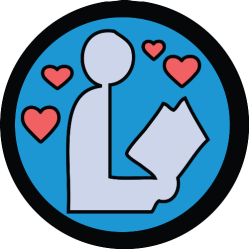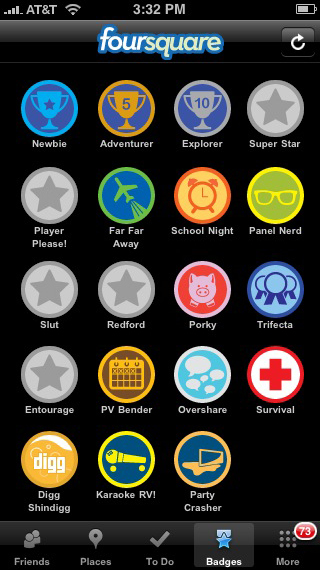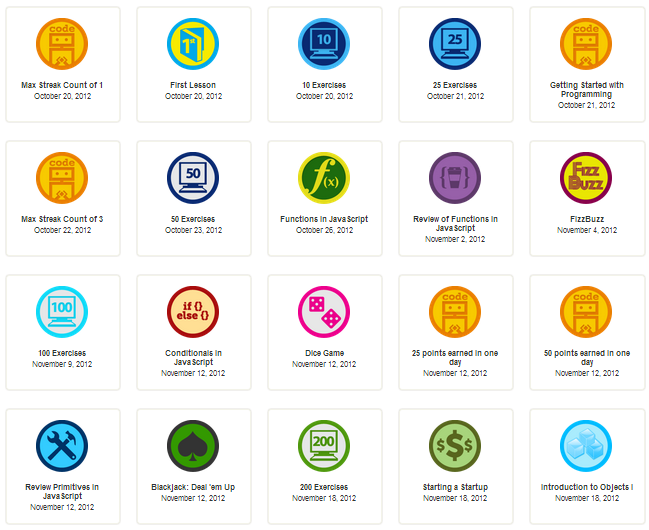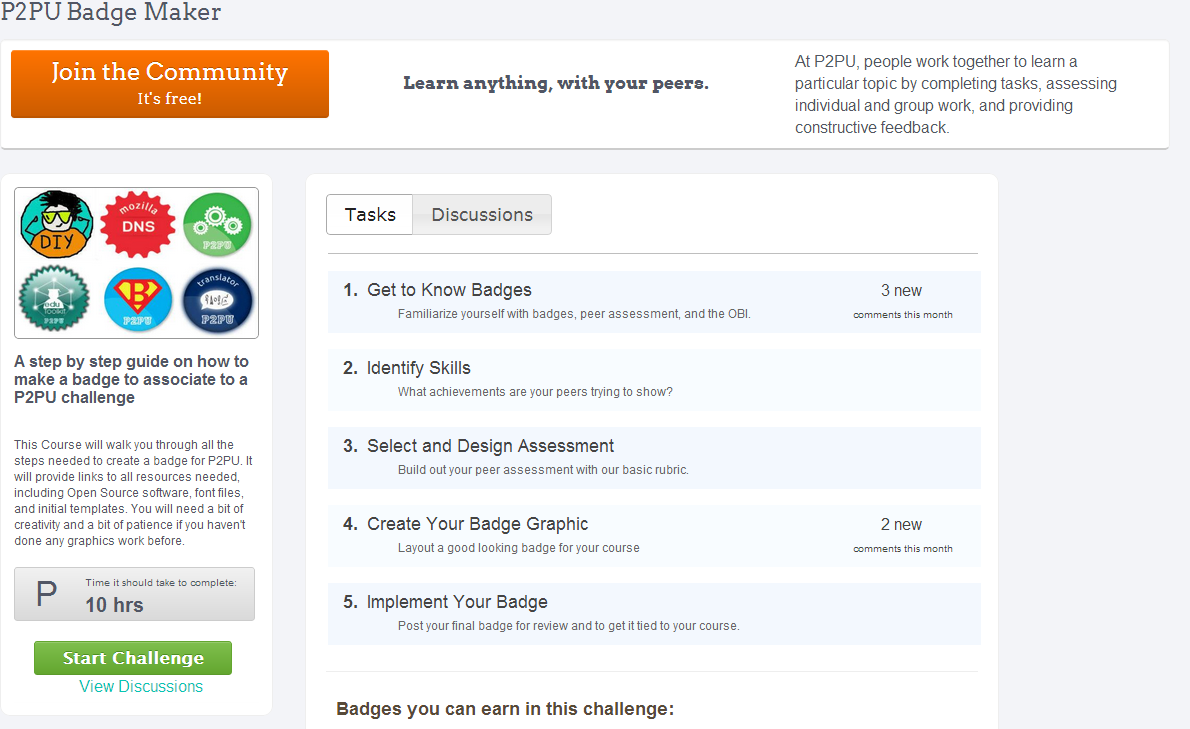Badging the Library: Part 1

This is the first post in a series talking about badges and what they mean for libraries. In this post, we'll focus on what badges are and why they might be important to libraries.
What is a badge?
Much like a scout badge, the badges we are talking about today are a way to recognize learning and reward achievement. As we explore more online learning contexts, and as libraries continue to develop online community-building tools, digital badges become a more important way to engage with and reward users for active participation. Badges can be used for a number of reasons, including "to set goals, motivate behaviors, represent achievements, and communicate success in many contexts."
An article at the front of the badge movement (back in 2010), has this description, worth sharing in its entirety:
"Badges are collectable, and that collection can made visible to other people. A badge collection tells the story of things that other people have declared about the person who owns the collection. A badge collection is also a set of things that the owner has chosen to share.
"This puts both the badge presenters and bearers in control of assertions—which means badges have something to say about all parties involved: The set of available badges is a comment on things valued by the community that presents them. Conversely, badges accepted and displayed by a person can help demonstrate what values he or she shares with the community.
"And beyond what they assert, badges are social objects. People have opinions about badges, the people who present them, and the people who claim them. Some applaud the sentiment behind particular badges; some congratulate the people who claim them; some people make plans to earn them. Some badges are more attractive than others, some are funny, and some are more difficult to achieve. This is all context that make badges interesting beyond just what they assert."
 Badges in the wild
Badges in the wild
Still not sure what we're talking about? You've probably seen badges on the web without realizing what they were. The popular location service, Foursquare, is built around rewarding badges for visiting certain locations. This photo, for instance, demonstrates badges rewarded during the SXSW event in Austin in 2009, an event that saw a total of 10,000 Foursquare check-ins and over 3,000 badges unlocked. Other popular games and game platforms (Farmville, Xbox Live, etc) reward badges for accomplishing certain tasks within the game or hitting certain benchmarks.
While badges have mainly be centered around game culture to date, with the rapid rise of online learning environments (MOOCs and such), they are expanding to fill other roles and promise to be a disruptive technology when it comes to online learning. Codecademy is a good example of an online learning platform with integrated badges.
Badges in the library
So how do we get from badges in games and websites to badges for the library?
That's an excellent question, and one that we will cover in a follow-up post. For the moment, we'll focus on why a library might want to implement badges, both for their patrons and their staff, and why badges could be important to librarianship in general.
Offering badges for your patrons can be a way to gamify the library experience. Readers could gain badges by reading enough books in a given genre, or by tackling a certain page count in a month, or by attending the library's book club meetings. Badges tie in perfectly with summer reading program activities, with event attendance, book sales, and even volunteer programs. Tying badges into these activities can help increase motivation and encourage more use of library resources among your patrons.
For library staff, badges could be used to recognize achievement, encourage growth, and even provide some friendly competition. Badging can tie in with circulation or reference desk tracker statistics (demonstrating, for example, who checks out the most books, answers the telephone most often, or gets the most questions about the location of the washroom). Libraries who want to nurture a game culture could have monthly contests for fastest shelver, trivia, or even after-hours book cart races (I know there are some book cart jockeys out there who find this idea appealing). Using badges as rewards for excellence not only gives library staff something to show off, they can also be of use when staff want to start moving up the library ladder into higher positions.

An example of badges earned from courses taken in Codecademy.
The most obvious use of badges for library staff, though, is to track learning. Badges are already being used with certain online learning platforms (re: Codecademy and others), and will likely find their way into MOOCs and other online classroom content soon, if they haven't already. In learning environments, badges encourage learners to excel and give them an easy method to show off their accomplishments.
And really, that's one of the nice things about badges: it's okay to show off. If someone were to whip out their graduate school transcript and start waving it around you would think they were showing off and it would probably be fairly obnoxious. On the other hand, if they had received an "MLIS Overachiever" badge during their studies, they could show it off much more openly, because recognizing one's own achievements, and having other people recognize them, is built in to the culture of badges.
Want to learn more?
 The conversation about badge integration with libraries is just getting started. This series will continue in a second post to talk more about the "how" of badge integration. In the meantime, here are some additional resources to learn about badges and how they are starting to be used in libraryland.
The conversation about badge integration with libraries is just getting started. This series will continue in a second post to talk more about the "how" of badge integration. In the meantime, here are some additional resources to learn about badges and how they are starting to be used in libraryland.
YALSA Badges for Lifelong Learning: Probably the biggest library-related badge project currently underway. Quite a few good posts on their blog and other information to help you learn more about badges.
P2PU (Peer-to-Peer University): Earn badges while you learn how to make badges in the P2PU Badge Maker course. It's a great example of how badges work in a learning environment and you'll learn how to start adding badges to your own projects.
- Homepage: https://p2pu.org/en/
- P2PU Badge Maker Course: https://p2pu.org/en/groups/how-do-i-make-a-badge/
Mozilla Open Badges: These guys are pretty much leading the badge charge and creating the open environment needed for badges to really take off. Check out the case study in Educause and see some of the current documentation and resources they have available.
- Homepage: https://openbadges.org/
- Educause article: http://www.educause.edu/library/resources/case-study-6-mozilla-open-badges
- Wiki: https://wiki.mozilla.org/Badges
- Blog: http://openbadges.tumblr.com/
GitHub: Badg.us FAQ: Badg.us is a service that preceded and an idea that inspired the current open movement from Mozilla (from what I can tell). There is good information here about what badges are and why they can be important.
- FAQ: https://github.com/lmorchard/badg.us/wiki/FAQ
- Blog post: http://decafbad.com/2010/07/badger-article/
Stay Tuned!
Check back soon for a follow-up article detailing the "how" of building and implementing badges for library services. [Badging the Library: Part 2 is now published.]
In the meantime, please use the comments to let us know if you're already using (or are thinking about using) badges for library patrons or staff.
